Auburn Oaks News
February 14, 2017
Auburn University will remove the current Auburn Oaks at Toomer's Corner and replace them with two new live oaks Saturday morning, Feb. 18.
"The fire in September severely damaged the Magnolia Avenue tree," said Gary Keever, Auburn University horticulture professor. "The appearance of the tree is unacceptable, and we don't believe it will recover within a reasonable time period."
University officials decided to replace the College Street tree, too, after finding two replacements that match each other in size and appearance.
"The College Street tree has failed to become established as you can see by dead branches at the top," Keever said. "If it had not been for the fire, though, we would have pruned those branches and continued nurturing both trees."
The famed, original Auburn Oaks were found to have been poisoned in early 2011. The university attempted to save the trees, but had to remove them once it was determined they would not survive. Two new trees were transplanted in 2015. The oak on Magnolia Avenue did not survive the move, so it was replaced a few months later by the tree that was subsequently damaged by the fire.
With a homecoming football game on Saturday's schedule, Auburn University is asking fans to refrain from rolling the Auburn Oak at Toomer's Corner that was intentionally set on fire last weekend. The restriction will be in place until further assessment of the tree's health can be made.
Fans celebrating are asked to keep any rolling to the Auburn Oak along College Street. The live oak alongside Magnolia Avenue was significantly burned by the fire, and experts won't know for some time the extent of the damage.
"There is little or no healthy foliage on the burnt tree. Most of the remaining leaves will drop off over the next week or so," said Gary Keever, professor of horticulture. "We will have to wait until next spring to see what long-term effects the fire had."
Keever will use a lift this week to more closely examine the canopy of the tree.
"I don't think the fire killed the tree, but we may never see it return to its appearance before this act," he said.
Auburn officials remind fans not to roll the 10 descendant oak trees lining the walkway between Toomer's Corner and Samford Hall. Those trees, planted earlier this year, were grown from acorns collected from the original Auburn Oaks.
Auburn hosts the University of Louisiana-Monroe Saturday at 2:30 p.m.
The future of the live oak tree at Toomer's Corner that was intentionally set on fire early Sunday morning will not be determined without closer inspection.
Professor of Horticulture Gary Keever will use a lift to get a closer look at the tree's canopy as early as Monday morning.
"From the ground we can easily see damage to the leaves and base of the tree. It is significant," said Keever. "I expect the foliage will continue to drop. The full extent of damage may not be known for several weeks. The best case scenario would be to see a flush of new growth next spring, but right now it's too early to tell how the tree will respond."
Landscape crews will need to replace irrigation pipes that watered the tree through the heat of the day, as much of it was melted by the intensity of the fire.
The Auburn Oak, located on the Magnolia Ave. side of Toomer's Corner, was damaged following Auburn's win over LSU Saturday night. It was the second celebration since Auburn resumed the rolling tradition this fall.
Auburn University will provide updates throughout the week on the extent of fire damage at www.auburn.edu/oaks.
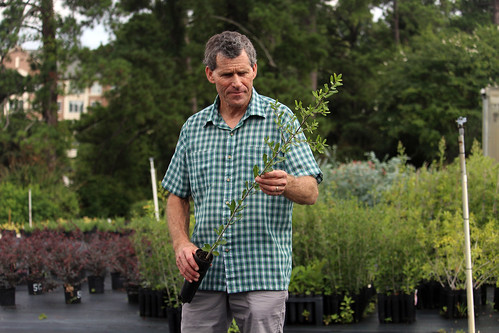
Auburn University's Department of Horticulture is offering seedlings from one of the new Auburn Oaks so fans can have part of the Auburn tradition at home. Proceeds from the sale of the two- to three-foot seedlings, grown from acorns of the College Street tree, go toward the department's academic programs.
"The tree formed new shoots in spring 2015 and produced acorns that summer and fall," said Gary Keever, horticulture professor. "Our faculty and students collected acorns in October and planted them in pots in a greenhouse on campus."
The two live oak trees at the College Street and Magnolia Avenue intersection form the famous Auburn Oaks at Toomer's Corner. They were transplanted as full grown trees in 2015 to replace the original trees that were removed in 2013 after being poisoned in 2011. The College Street tree was transplanted in February 2015 and the Magnolia Avenue tree in July 2015.
"Because a live oak doesn't require a period of low temperature for its acorns to germinate, the acorns sprouted within two or three weeks, and the seedlings grew throughout last winter," Keever said. "In the spring, the seedlings were moved outdoors to continue growing. They have straight trunks, dark, glossy foliage and vigorous root systems."
Trees may be purchased for $125 from the College of Agriculture website at http://www.ag.auburn.edu/auburnoaks/. Sales will include a certificate identifying the tree as a first generation descendant of the new Auburn Oaks, as well as planting and care instructions. The Department of Horticulture also has clones and seedlings from the original Auburn Oaks for sale. More information is available on the website or by contacting Heath Hoffman at 334-844-4660.
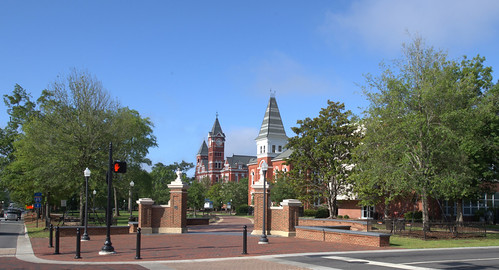
Auburn University football fans will enjoy rolling the two new Auburn Oaks at Toomer's Corner with toilet paper this fall, marking the return of one of college athletics' best-known traditions.
"This is a tremendous day for the Auburn Family and for all sports fans across the country who love the fall and football," said Ron Booth, executive director of facility operations. "Our hope has been to reinstate rolling this season, and, now, we can make that announcement."
The tradition is for fans to throw rolls of toilet paper over the limbs after Auburn wins. As the new trees continue to get established in the soil, university officials are welcoming "gentle" rolling of the two oaks by asking fans not to cross the fences encompassing the trees and to not climb on the trees.
"We are still conscious of making sure the trees stay healthy," said Gary Keever, Auburn University horticulture professor. "We also have water systems in place below the trees and even water pipes to the top that we need to protect. The toilet paper will be removed by hand after each rolling."
The university is asking fans not to roll any other trees in Samford Park, including the 10 smaller oak trees lining the walkway from Toomer's Corner to Samford Hall. Those trees, descendants of the original oaks, were planted in the spring and are not fully established. Donors have the opportunity to name the special trees as a way to raise funds for scholarships in the School of Forestry and Wildlife Sciences, with five already having been named.
Auburn officials temporarily halted the tradition in 2013 as a result of the original oaks being poisoned in 2011. The university attempted to save the trees, but had to remove them once it was determined they would not survive. Two new large trees were planted in 2015. The oak on Magnolia Avenue did not survive the move, so it was replaced a few months later.
"We appreciate everyone's patience during the past few years," Booth said. "This is a return to one of the greatest traditions in college athletics. We ask that you roll the trees without crossing the fences and not to roll the descendant oaks in Samford Park.
"The Auburn Family can once again enjoy rolling the corner."
More information about the Auburn Oaks at Toomer's Corner is available at http://www.auburn.edu/oaks.
After monitoring the declining health of the Magnolia Oak at Toomer’s Corner, which was planted Feb. 14, Auburn University’s Tree Preservation Committee, Facilities Management Division and tree contractor Tim Thoms decided to replace it, which was done July 8. The College Street Oak planted in February has adapted well; the planting of the oaks was the final step in Phase I of the Samford Park redevelopment project. Phase II began in May with construction of a brick arcing walkway that will lead from Toomer’s Corner to Samford Hall. The latter part of Phase II will take place winter 2016 with the planting of live oaks, descendants of the original Auburn Oaks, along the new walkway.

Auburn University will remove the Auburn Oak on West Magnolia Avenue and replace it with a live oak of the same size in early July.
"We've worked closely with the tree contractor and our Facilities Management Landscape Services team to provide the best care for the oaks, but the lack of bud growth on the Magnolia Avenue tree has caused concern for its long-term viability," said Ben Burmester, Auburn University campus planner.
Although the tree is alive, it seems to be surviving on stored carbohydrates from the existing roots and not producing any new root growth to force new bud/leaf growth, said Steven Johnston, Auburn University Facilities Management landscape superintendent.

The Special Collections and Archives Department of Auburn University Libraries will host an exhibit of messages and other artifacts left at the Auburn Oaks in the days following the announcement in early February 2011 that the trees had been poisoned. The exhibit, which will run Feb. 14 until A-Day weekend in April, is located on the first floor of the Ralph Brown Draughon Library and will be open during all regular library hours.
The artifacts gathered at the trees slated to be in the exhibit include many get-well wishes for the trees from small children and adults alike and tributes from current and former students. These artifacts take all shapes from simple cards and signs to the victory-celebration signature item - rolls of toilet paper.
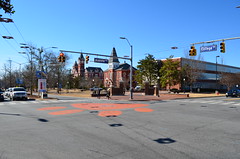
Nearly four years to the day that Auburn University announced the lethal poisoning of the historic Auburn Oaks, two new live oaks will begin taking root in Samford Park at Toomer’s Corner.
Landscapers are scheduled to begin planting the 35-foot-tall trees at 8 a.m. on Feb. 14. The university is inviting the public to attend the event, which should finish early in the afternoon. A viewing area will be set up, and streets will be closed for safety reasons.

Auburn University's Samford Park is undergoing a facelift to clear walkways, add vibrant year-round color and increase greenspace.
Landscape crews recently began work by removing shrubs from plant beds in front of Hargis Hall. This work will continue in phases, moving toward Langdon and Samford Halls and the famed Auburn University sign before wrapping up in early spring.
The Auburn University Board of Trustees recently approved initiation of the second phase of a plan to renovate Samford Park. The plan calls for 30 live oak trees, grown from acorns taken from the iconic Auburn Oaks 12 years ago and now 15 feet tall, to be planted along a new brick walkway that will connect Samford Hall to Toomer's Corner.
The university also announced that two large live oaks will be planted at the College Street and Magnolia Avenue intersection on Feb. 14, 2015, completing Phase I of the project.
Auburn fans can carry on the tradition of the Toomer's Corner live oaks in their own yards. This fall the Department of Horticulture in the College of Agriculture is selling seedlings and clones of the famed oaks.
A School of Forestry and Wildlife Sciences project generated sales of 800 oak seedlings, which were sold in a lottery following more than 6,000 requests during the last year of the program. The program ended when the oaks stopped producing acorns and were eventually removed.
Keever and his team were able to propagate more than 2,000 rhizomic shoots from the oaks before their removal and have grown them to 1-3 feet tall.
Although the exact species of trees that will replace Auburn's famed oaks has yet to be determined, the literal foundation for their survival is nearing completion at Toomer's Corner. The future oaks – scheduled for planting in early 2015 – will grow in a high-tech environment that will maximize their chances of living many years.
Construction crews have installed a modular, underground structural system known as Silva Cells, which are designed to support large tree growth while reducing soil compaction and providing stormwater management. The project in Samford Park is the first in Alabama to use Silva Cell technology.
Following excavation and extensive testing, the soil around Samford Park at Toomer's Corner has been declared free of poison after more than three years.

Phase I of the redevelopment and enhancement of Samford Park at Toomer's Corner is scheduled to begin Wedesday, April 2. In preparation for the work, the iconic eagles perched on top of the 1917 brick gates will be temporarily taken down Thursday morning, March 27, by The Lathan Company Inc., a Mobile-based firm which restored the eagles in April 2012. The eagles will be stored on campus and returned to the corner upon completion of the project. The gates will remain on site during construction.
The project will begin with the installation of fencing around the perimeter of the worksite and the closure of a number of sidewalks in Samford Park as well as the crosswalks at the corner of West Magnolia Avenue and South College Street. Pedestrians are asked to use the midblock crosswalks on West Magnolia Avenue and South College Street for access to the downtown area from the university.
At times during construction, the right-hand, southbound lane on South College Street will be temporarily closed to accommodate construction traffic. Motorists are urged to use caution when traveling near the worksite.
Phase I includes the installation of new pavers, soil replacement and a circular seating wall. This work is expected to be completed prior to the start of the fall 2014 semester. Phase I also includes the planting of new trees, which will take place in early 2015.
J.A. Lett Construction Company Inc. of Auburn, Ala., was awarded the project on March 11, 2014.
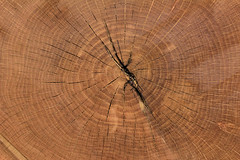
Growth rings from the base of Auburn University's College Street live oak at Toomer's Corner have revealed the tree's age of 83-85 years old at the time they were removed April 23.
This week, two Auburn professors independently counted 81 growth rings in two directions from the center of the tree's trunk.
"The center one-inch section of the trunk was split and not clearly delineated," said Professor of Horticulture Gary Keever. "This growth most likely occurred over two to four years, making the trees 83-85 years old."
Auburn fans will soon have a way to remember the oaks at Toomer's Corner long after the trees are gone. To commemorate the tradition of rolling the oaks, the university will be working with several licensed manufacturers to create mementos from the trees' wood following their removal later this month. All royalties collected from their sale will benefit Auburn students through a special scholarship fund.
“This is a very special way for the Auburn Family to remember one of our best-known traditions,” said Debbie Shaw, vice president for alumni affairs. “Generations of our fans have gathered beneath the oaks over the years, and it is fitting that future generations of students will benefit from the scholarships they will provide.”
After two years of extraordinary efforts to save the poisoned Auburn Oaks at Toomer's Corner, Auburn University plans to remove them on April 23, weather permitting.
The final opportunity for fans to roll the beloved Auburn Oaks will follow the A-Day football game April 20 when the university and City of Auburn host a "Celebrate the Tradition" block party

Auburn University and the City of Auburn will host a "Celebrate the Tradition" block party at Toomer's Corner on Saturday, April 20. The event will be held after the A-Day football game and will give fans one final opportunity to roll and photograph the beloved oak trees before the trees are removed.
A date for the trees' removal has not been set.
"The Oaks at Toomer's Corner have been a part of Auburn tradition for generations," said Debbie Shaw, Auburn University vice president for alumni affairs and executive director of the Auburn Alumni Association. "Their removal will in no way diminish the Auburn Spirit, which has grown even stronger during these past two years."
The Oaks at Toomer's Corner were damaged by fire early Sunday morning. Members of the Trees Task Force examined the trees Monday morning and found significant damage to both oaks and to several plants adjacent to the plaza. The Trees Task Force will post an update about the fire damage next week. The Auburn Police Division is investigating the incident.
Since our June update from the Trees Task Force, there has been nothing new to report regarding the health of the trees. They continue to defoliate and re-foliate, as expected when the pesticide tebuthiuron is applied. The prognosis for their survival, as described since we first learned of the poisoning, remains poor, and the university is continuing to monitor them, irrigate them, and collect and remove fallen leaves from the site to avoid contamination of other areas.
It is likely that it will be at least spring 2012 – at the earliest – before we know if the trees will survive.
Members of the task force from horticulture, forestry, and agronomy and soils are in agreement that rolling the trees is not harmful, and have advised university administration that if the rolling celebration continues, they be cleaned by hand, rather than with power hoses as in the past. The high pressure hoses can injure the trees by knocking off foliage, leaves and bark. We also recommend the barricades around the beds remain in place indefinitely.
Short-term decision regarding rolling Toomer's Corner
After months of reviewing options and obtaining input from the campus, the community and the team of horticultural, agronomy and soils, and forestry experts working to save the trees, Auburn University and the city will allow the tradition of rolling Toomer's Corner to continue, at least temporarily, this fall. At the recommendation of our experts, the university will no longer use high pressure hoses to clean the trees; they will be cleaned by hand.
Many alternatives were carefully considered, including suspending the tradition or moving it elsewhere. Most of these options created new or additional concerns related to crowd control, traffic, safety issues for our fans and opposing teams' fans, easy access, community property, and the health of other landscaping and park-like areas.
We ask our fans NOT to move the celebration into Samford Park, the beauty of which we are also trying to preserve, and where, with no concrete base to protect it, landscaping and vegetation is fragile.
Future Opportunities
The university's Facilities Division is exploring a long-term solution we hope will return the tradition permanently: Create an iconic, attractive intersection structure, in partnership with the city and with its approval. The intent of the structure would be to:
Bring the celebration back to the Corner, where it originated, not in the trees area;
Create something in which the campus and community could take great pride;
Enhance community-wide events, holidays, and gatherings year-round while improving the look and feel of the intersection overall.
A steering committee will be formed to explore this option and set parameters for an architectural design contest, which would include involvement by members of the Auburn Family. More details will be announced in the coming weeks.
Finally, hundreds of suggestions regarding replacement of the trees have been submitted by our fans and supporters, signifying their love of the university and its traditions. We have compiled these ideas and, if we determine the trees will not survive, which our experts say will likely not be possible until at least next spring, will review them at that time.
A descendant of the Toomer's Corner oak trees will be planted on the grounds of the U.S. Capitol Friday morning, the idea of a Florida congressman who is a 1981 Auburn University alum. U.S. Rep. Dennis Ross, R-Fla., started the process of getting permission to plant the tree well before the original oaks were poisoned, but the attack gave the idea even more merit, he said. "That just made it more important that we get it done," Ross said Friday. The architect of the U.S. Capitol, plus House and Senate leaders, had to approve the tree's addition to the Capitol grounds. Although the oaks have become famous for their sports-related celebrations, he said it's Auburn's contributions as a land grant college he wants to honor. "It symbolizes the heritage that land grant institutions provide this country," Ross said.
Results of water samples taken from underground wells in the area of the Toomers Oak trees returned from Data Analysis Technologies in Ohio showing only minor trace elements of Spike 80DF, the pesticide that was used to poison the trees. The levels found were well below what would cause a threat to public health or the environment. Tests were conducted as a precaution even though the water in the area beneath the trees is not tied to drinking water in the Auburn area.
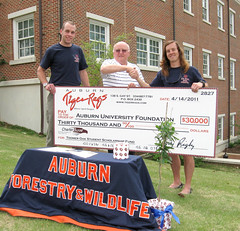
Jerry Rigby (center), president of Tiger Rags Inc., presented a $30,000 check Thursday to the Auburn University School of Forestry and Wildlife Sciences for student scholarships. Accepting the check were Ryan Mitchell (left), president of the Student Government Association in the School of Forestry and Wildlife Sciences, and Russell Agnew (right), Toomer's Corner Oaks coordinator for the school's Forestry Club. Tiger Rags created two special Auburn T-shirts following the news in February that the oaks at Toomer's Corner had been poisoned, with $8 of the proceeds from each shirt sold being donated to the scholarship fund. Additional donations will be made as more shirts are sold during the summer and upcoming football season. Tiger Rags has partnered with the School of Forestry and Wildlife Sciences since 2003 to raise money for student scholarships by selling seedlings from Auburn's famous Toomer's Corner Oaks.



